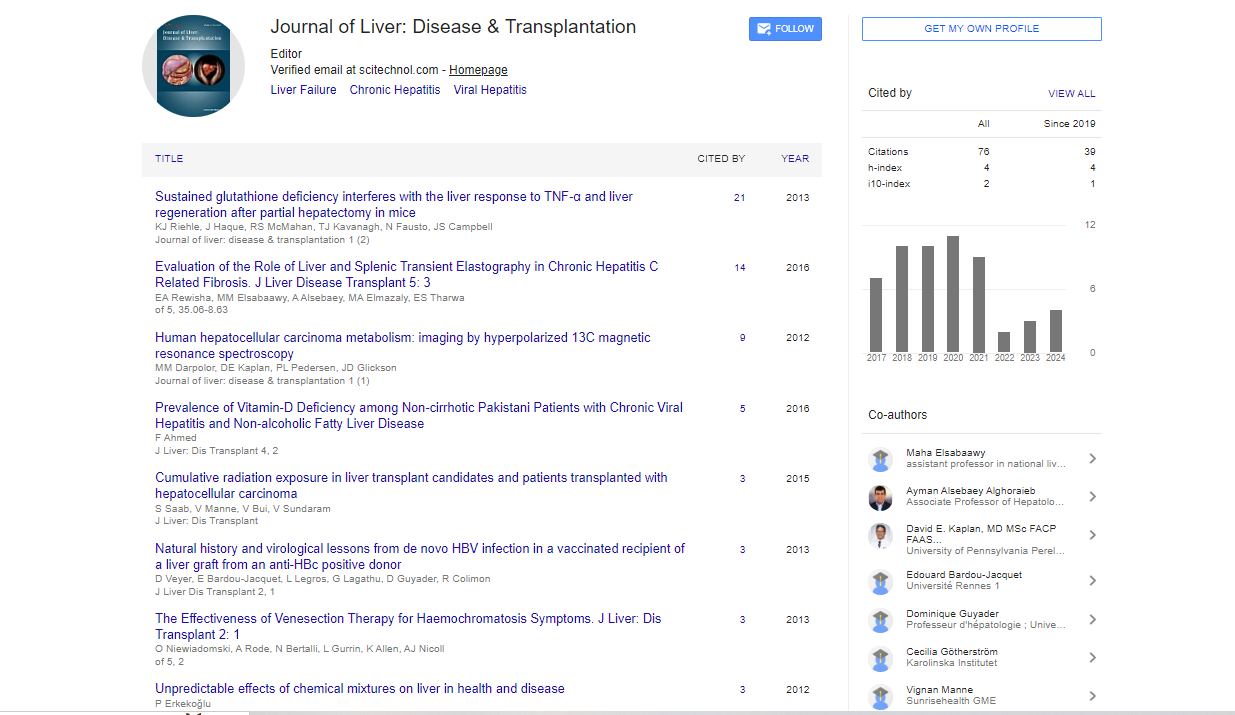Commentary, J Liver Disease Transplant Vol: 13 Issue: 1
Orthotopic Liver Transplantation: A Comprehensive Review of Surgical Techniques, Outcomes, and Advances
Zanh Hu*
1Department of Hepatobiliary Surgery, Fourth Military Medical University, Shaanxi, China
*Corresponding Author: Zanh Hu,
Department of Hepatobiliary Surgery, Fourth
Military Medical University, Shaanxi, China
E-mail: hu.zang@163.com
Received date: 12 February, 2024, Manuscript No. JLDT-24-135119;
Editor assigned date: 14 February, 2024, PreQC No. JLDT-24-135119 (PQ);
Reviewed date: 28 February, 2024, QC No. JLDT-24-135119;
Revised date: 06 March, 2024, Manuscript No. JLDT-24-135119 (R);
Published date: 13 March, 2024, DOI: 10.4172/2325-9612.1000261.
Citation: Hu Z (2024) Orthotopic Liver Transplantation: A Comprehensive Review of Surgical Techniques, Outcomes, and Advances. J Liver Disease Transplant 13:1.
Description
Orthotopic Liver Transplantation (OLT) stands as a remarkable achievement in modern medicine, offering a definitive treatment option for end-stage liver disease and selected cases of acute liver failure. Since its inception in the 1960s, OLT has undergone significant refinements in surgical techniques, immunosuppressive regimens, and perioperative care, leading to improved patient outcomes and expanded indications. The roots of OLT trace back to the pioneering work of and his team at the University of Colorado in the 1960s. Despite initial challenges and high rates of mortality, their perseverance laid the foundation for subsequent advancements in surgical techniques and immunosuppression, culminating in the first successful liver transplant in 1967. Over the ensuing decades, OLT evolved from an experimental procedure to a standard of care, with refinements in organ preservation, donor selection, and perioperative management contributing to improved outcomes and increased survival rates.
The success of OLT hinges upon meticulous surgical technique and careful patient selection. The procedure involves the removal of the diseased liver (native liver) and its replacement with a healthy donor liver in the anatomical position (orthotopic placement). Surgical access is typically achieved through a midline abdominal incision, allowing for optimal exposure of the liver and meticulous dissection of vascular structures. Hepatic artery, portal vein, and hepatic vein anastomoses are performed to restore blood flow to the transplanted liver, while bile duct reconstruction facilitates bile drainage and hepatobiliary function. Variations in surgical technique may arise depending on the presence of vascular anomalies, previous abdominal surgeries, and anatomical considerations, necessitating adaptability and expertise on the part of the surgical team.
The post-transplant period is characterized by intensive monitoring, immunosuppressive therapy, and multidisciplinary care to mitigate the risk of rejection, infection, and other complications. Immunosuppression regimens typically involve a combination of calcineurin inhibitors (such as tacrolimus or cyclosporine), antimetabolites (such as mycophenolate mofetil), and corticosteroids, tailored to individual patient characteristics and risk factors. Close surveillance for signs of rejection, graft dysfunction, and infectious complications is paramount, necessitating regular clinic visits, laboratory monitoring, and imaging studies. Additionally, attention to long-term complications, including graft fibrosis, renal dysfunction, and malignancy, remains essential for optimizing patient outcomes and ensuring graft longevity.
Despite significant advancements in surgical techniques and immunosuppressive regimens, OLT remains a complex procedure associated with inherent risks and challenges. While overall survival rates have improved substantially over the past few decades, variations in patient outcomes exist based on factors such as recipient age, comorbidities, donor characteristics, and transplant center volume. Early complications, such as graft rejection, vascular thrombosis, and biliary complications, can impact short-term outcomes, while longterm complications, including chronic rejection and de novo malignancies, pose challenges to graft survival and patient well-being. Nevertheless, with proper patient selection, perioperative management, and adherence to immunosuppressive therapy, OLT offers the potential for prolonged survival and enhanced quality of life for recipients with end-stage liver disease.
Recent years have witnessed notable advances in the field of OLT, driven by innovations in surgical techniques, immunosuppressive agents, organ preservation methods, and donor selection criteria. Minimally invasive approaches, including laparoscopic-assisted liver transplantation and robotic-assisted surgery, have emerged as promising alternatives to conventional open techniques, offering reduced blood loss, shorter hospital stays, and enhanced recovery. Furthermore, advancements in immunosuppression, such as the development of novel agents targeting specific immune pathways, hold promise for improving graft survival while minimizing adverse effects associated with traditional regimens. Additionally, advancements in organ preservation techniques, including machine perfusion and normothermic ex vivo liver perfusion, offer opportunities for expanding the donor pool, optimizing graft function, and reducing ischemia-reperfusion injury.
Conclusion
In conclusion, orthotopic liver transplantation stands as a transformative intervention for patients with end-stage liver disease, offering the potential for prolonged survival and improved quality of life. Through decades of clinical experience, research endeavors, and technological innovations, OLT has evolved into a highly specialized field of transplant medicine, characterized by multidisciplinary collaboration, meticulous surgical technique, and personalized patient care. By elucidating the historical evolution, surgical considerations, post-transplant management, outcomes, and recent advances in OLT, this review aims to provide valuable insights for healthcare professionals and researchers, fostering continued progress and innovation in the field of liver transplantation.
 Spanish
Spanish  Chinese
Chinese  Russian
Russian  German
German  French
French  Japanese
Japanese  Portuguese
Portuguese  Hindi
Hindi 